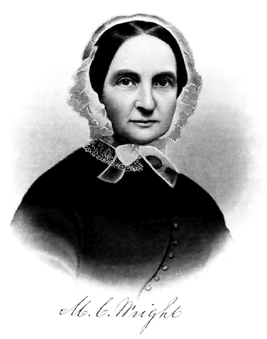Martha Coffin Wright facts for kids
Quick facts for kids
Martha Coffin Wright
|
|
|---|---|
 |
|
| Born | December 25, 1806 Boston, Massachusetts, U.S.
|
| Died | 1875 (aged 68–69) |
| Occupation | American activist |
| Spouse(s) | Peter Pelham David Wright |
| Relatives | Lucretia Coffin Mott (sister) William Lloyd Garrison, Jr. (son-in-law) Mayhew Folger (maternal uncle) Levi Coffin (cousin) |
Martha Coffin Wright (December 25, 1806 – 1875) was an American activist who worked for women's rights and to end slavery. She was one of the people who signed the Declaration of Sentiments, a document asking for equal rights for women. Martha was also a close friend and supporter of Harriet Tubman.
Contents
Early Life and Education
Martha Coffin was born in Boston, Massachusetts, on Christmas Day in 1806. She was the youngest of eight children. Her parents were Anna Folger and Thomas Coffin, a merchant and former ship captain from Nantucket.
When Martha was two years old, her family moved to Philadelphia. There, she went to schools run by the Quakers. Her father passed away in 1815 when she was nine. Martha was greatly influenced by her older sisters and her mother. Her oldest sister, Anna, sent Martha to the Westtown School in 1821, which was a Quaker boarding school. After living in Philadelphia for 15 years, Martha moved to Aurora, New York, in November 1827.
Working for Change
The Seneca Falls Convention
Martha's older sister, Lucretia Coffin Mott, was a well-known Quaker speaker. In July 1848, Lucretia visited Martha's home in Auburn, New York. During this visit, Martha and Lucretia met with Elizabeth Cady Stanton at Jane Hunt's house. They decided to hold a meeting in nearby Seneca Falls, New York. This meeting was to talk about the need for more rights for women.
This meeting became known as the Seneca Falls Convention. It was the very first women's rights convention. Its importance was recognized by the U.S. Congress in 1980. They created the Women's Rights National Historical Park at the site. This park has statues of the women and men who started the organized movement for women's rights in 1848. One statue shows Martha, who was pregnant at the time.
Fighting for Women's Rights and Against Slavery
After the Seneca Falls Convention, Martha Wright took part in many state and national women's rights conventions. She often led these meetings as president. She was also very active in the movement to end slavery, known as abolitionism. The reasons for women's rights were very similar to the reasons for ending slavery.
With her sister Lucretia, Martha attended the first meeting of the American Anti-Slavery Society in Philadelphia in 1833. In September 1852, Martha gave her first speech about women's rights at a convention in Syracuse, New York. It was at this meeting that she first met Susan B. Anthony. Martha continued to attend many conventions and lectures until 1862. When the Civil War began, she felt it was important to focus on the war effort. However, she still continued her work with the American Anti-Slavery Society.
Helping the Underground Railroad
Martha's home in Auburn, New York, was a safe place for people escaping slavery. This network of safe houses was called the Underground Railroad. She became a close friend and helper to Harriet Tubman, who guided many enslaved people to freedom.
Martha and her husband, David, were very important in the movement to abolish slavery. They shared this interest with their friends, the Seward family, in Auburn, New York. William Henry Seward was the governor of New York State at that time. His wife, Frances Seward, and his sister, Lazette Worden, also became interested in the women's rights movement.
Martha's Auburn Home
In 1839, the Wright family moved to a large house at 192 Genesee Street in Auburn, New York. This house was important for her husband David's work as a lawyer because it was close to the courthouse. It also became a key place for hiding people escaping slavery and for hosting important figures in the women's rights movement. Famous visitors included Frederick Douglass, William Lloyd Garrison, Elizabeth Cady Stanton, and Susan B. Anthony.
Personal Life
In 1824, Martha married Captain Peter Pelham and moved with him to Florida. They had a daughter. Peter died in July 1826, leaving Martha as a 19-year-old widow with a baby. She then moved to upstate New York to teach painting and writing at a Quaker school for girls.
Martha had six children in total: Marianna (with her first husband), Tallman, Eliza, Ellen, William, and Francis. After her first husband's death, she met Julius Catlin. They wanted to get married in 1828, but his father did not approve, and Julius died that same year. In 1829, Martha met David Wright, a lawyer, and they were married on November 18. David Wright was also a Quaker.
Martha's daughter, Ellen Wright (1840–1931), also worked for women's rights, especially for women to have the right to vote. In 1864, Ellen married William Lloyd Garrison, Jr. He was the son of the famous abolitionist William Lloyd Garrison.
Death
Martha Coffin Wright passed away on January 4, 1875. She is buried in Fort Hill Cemetery in Auburn, New York.
Family Legacy
Martha's granddaughter, Eleanor Garrison (1880–1974), continued her family's work. Eleanor worked for the National American Woman Suffrage Association, which fought for women's right to vote.
Recognition
On October 9, 2007, the U.S. House of Representatives passed a resolution honoring Martha Coffin Wright. This resolution recognized her on the 200th anniversary of her birth and her entry into the National Women's Hall of Fame.
Images for kids
See also
 In Spanish: Martha Coffin Wright para niños
In Spanish: Martha Coffin Wright para niños






